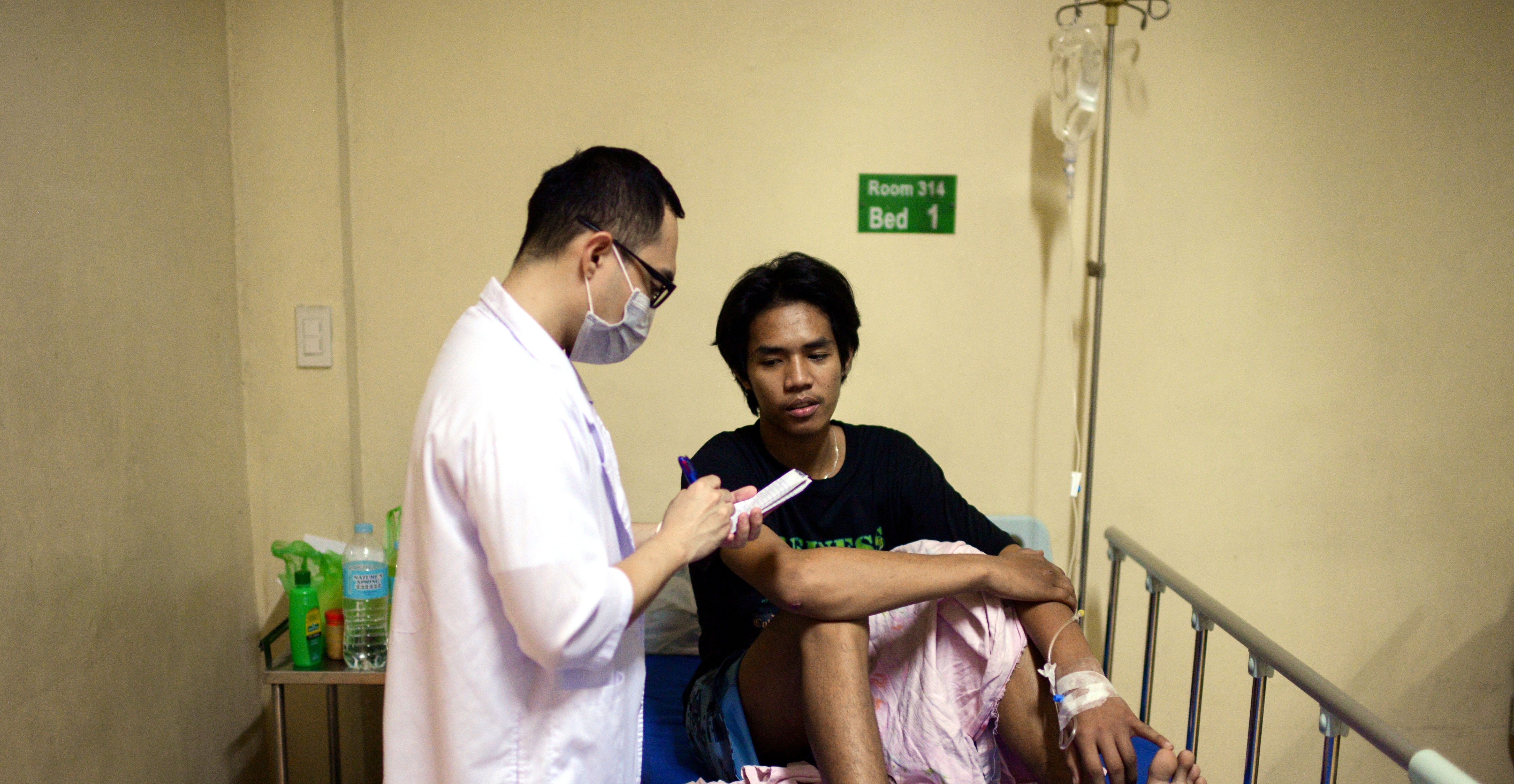COVID-19: Suppression is possible but at what cost to our privacy?

Image: REUTERS/Yara Nardi - RC2SJG9N8OEQ
- Eradicating COVID-19 is possible through a combination of case detection and social distancing, writes economics PhD candidate Stefan Pollinger.
- These measures would allow the pandemic to be eliminated at low additional economic and health costs.
- The optimal policy is easily implementable, but it raises important privacy concerns, which need to be addressed in political discussion.
What is the optimal response to a rapidly spreading and deadly infectious disease, when no vaccine or efficient medication is available? Despite the enormous efforts of policymakers and citizens alike, global case numbers are still increasing. While some countries brought the viral spread under control, others have failed to do so.
One strategy to end the crisis is the suppression of COVID-19 (e.g. Bethune and Korinek 2020, Pueyo 2020).1 Suppression policies push the viral growth rate below zero, such that prevalence – the number of infectious individuals in the population – decreases permanently. As a consequence, the virus dies out in the long run. Arguably, many governments are following this policy. However, suppressing the virus is not simple. Current resurgences in case numbers show that policymakers around the world are struggling to find the optimal suppression path. Moreover, suppression measures are a heavy burden on citizens' wellbeing and the economy, casting doubts about whether suppression is indeed the best way out.
Suppression at a reasonable cost is possible
My research (Pollinger 2020) suggests that an optimal combination of social distancing and case detection allows for the suppression of COVID-19 at low additional human and economic costs. Additionally, the optimal policy can be characterised by a simple formula, making it easily implementable. Social distancing policies decrease the growth rate of the virus by reducing the rate of social contacts between all individuals in the population. Case detection policies, such as contact tracing, find and isolate infectious individuals from the susceptible population. The optimal policy minimises total economic and health costs.2
To limit the overall cost of suppression, the combination of case detection and social distancing is crucial. Relying only on social distancing poses two problems. First, social distancing affects all individuals in a population, making it very costly. Second, because the decrease in viral prevalence follows an exponential decay process, social distancing becomes very inefficient when prevalence is low. It takes the same effort to reduce the number of infected from 20,000 to 10,000 as it does to reduce it from from 20 to 10. Towards the end of a pandemic, it is necessary to impose costly measures on the whole population just to avoid one last transmission of the virus. Case detection offers a solution to these problems. The lower the number of undetected cases, the greater the resources a country can put towards detecting a single case. As a consequence, the detection rate, and therefore the efficiency of detection, is highest when prevalence is low, and vice versa. Thus, social distancing and case detection perfectly complement each other, which curtails the cost of suppression.
I find that optimal social distancing decreases when viral prevalence decreases. The lower the caseload, the higher the growth control exerted by case detection. This property has clear-cut policy implications. Suppose a policymaker discovers a first outbreak or a resurgence in case numbers (i.e. a second wave). In the optimum, she immediately implements social distancing measures to reverse viral growth. Importantly, it is never optimal to ‘smooth in’ social distancing or to wait before imposing measures, a widely made mistake at the beginning of the COVID-19 pandemic. While some policy mistakes are attributable to the high degree of uncertainty, delays in the accurate response are not. Any hesitation in implementing sufficiently strong social distancing measures only worsens economic and health outcomes because weak policies allow the virus to grow exponentially, which increases the number of casualties and the time and intensity of a subsequent lock-down.
The optimal policy over time
The critical dynamic trade-off when suppressing the virus is between the intensity of social distancing and the time it needs to stay in place. Too extreme measures rapidly reduce the amount of infections in the population but have very high instantaneous costs, because even the most fundamental economic activities are on hold. Too weak measures have low instant costs; but to eradicate the virus, they need to stay in place for a very long time.
The optimal policy trades off these margins at every instant. I characterise it by a simple formula of two observable statistics: first, the instantaneous (negative) growth rate of the virus; and second, the instant flow of costs from suppression measures and health outcomes. The formula gives specific guidance on how to relax social distancing measures. The policymaker needs to evaluate the relative effect of changing the set of imposed measures on the current flow of costs and the viral growth rate. If the percentage reduction in cost is larger than the percentage increase in growth, the set of imposed measures should be reduced further. Following this simple rule keeps the economy on the optimal suppression-path. It minimises the total cost by avoiding needless resurgences of cases or excessive precautions. In contrast to a first intuition, too lax social distancing, such as a premature exit from lock-down, does not ease the overall economic burden. On the contrary, it prolongs the necessity of costly measures in the future. Surprisingly, health costs play only a minor role for suppression. The optimal policy works mainly to minimise the economic impact of the pandemic.3
How much will it cost, and is it better than aiming for herd immunity?
The results discussed so far are theoretical, and therefore robust to the huge parameter uncertainty related to Covid-19. However, theory is unable to answer two crucial questions. What are the economic and health costs of the optimal suppression policy under the use of different detection technologies? And, how do these costs compare to the costs of optimal mitigation policies?4 Due to the high parameter uncertainty, a precise answer to these questions at this point is impossible. Following the literature, I use a simulation exercise to obtain approximate answers.
I simulate my model with the case of Italy. I assume Italy starts to follow the optimal suppression policy on 11 May, when 0.1% of the population was still infected. Results for countries with similar prevalence – the US, for instance5 – are comparable. To understand the impact of the detection technology, I calculate the optimal policy and its cost for three different detection scenarios. In the first scenario, Italy uses fast and efficient digital contact tracing, as did South Korea. I find that the total cost of suppression is only 0.8% of annual GDP. The virus dies out after 3.7 months, and the number of additional casualties is around 3,500. Additionally, the strategy is robust to a certain degree of imported cases. In a second scenario, Italy uses slower and less efficient manual tracing. In this case, the total cost is 2.7% of GDP, the virus dies out after 15 months, and the number of additional casualties is again around 3,500. In the third scenario, Italy continues to detect cases at its current low rate.6 In stark contrast, the total cost is 14% of annual GDP, extinction occurs after 7.6 months, and additional casualties amount to 6,000. Moreover, in the manual tracing and low tracing scenarios, if new cases are imported from abroad after extinction, the pandemic restarts. Therefore, meticulous border controls need to stay in place until a vaccine arrives. As discussed by Monràs (2020) and Oliu-Barton et al. (2020), movement must be restricted to zones with comparable prevalence.
In comparison, the cost estimates for optimal mitigation strategies range from 7% to 30% of annual GDP (Gollier 2020, Acemoglu et al. 2020, Alvarez et al. 2020). The most optimistic estimates for additional casualties are 0.2% of the population (120,000 in the case of Italy). The comparison suggests that the health and economic costs of the most efficient suppression policy are by an order of magnitude lower than of the most efficient mitigation policy.
Conclusion
Saving lives and economic prosperity by ending the pandemic is possible. Efficient case detection could be at the centre of such an exit strategy. However, the policy raises important concerns related to privacy. It is time to have a serious political discussion about these concerns. The opportunity costs of not doing so are substantial.
Don't miss any update on this topic
Create a free account and access your personalized content collection with our latest publications and analyses.
License and Republishing
World Economic Forum articles may be republished in accordance with the Creative Commons Attribution-NonCommercial-NoDerivatives 4.0 International Public License, and in accordance with our Terms of Use.
The views expressed in this article are those of the author alone and not the World Economic Forum.
Stay up to date:
COVID-19
Forum Stories newsletter
Bringing you weekly curated insights and analysis on the global issues that matter.






